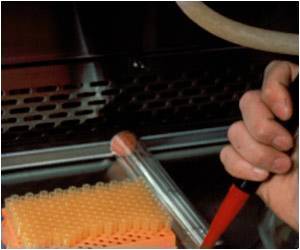Mitochondria need to produce a very specific oxidative signal in response to muscle damage in order to help injured muscles repair.

‘There is a need to take a nuanced view of the role of reactive oxygen species, as they are necessary when they are present at the right place and right time.’





Although reactive oxygen species can damage cells when produced in high amounts, according to a study published online by Science Signaling and featured on the journal's cover, these oxidative species are crucial signals that start the process of repairing myofiber. Mitochondria serve as the cell's powerhouse and supply energy for producing force, but this process also makes reactive oxygen species as a by-product. Properly functioning mitochondria are needed not only for energy production, but also to repair injured myofibers.
"Our results suggest a physiological role for mitochondria in plasma membrane repair in injured muscle cells, a role that highlights a beneficial effect of reactive oxygen species," says Jyoti K. Jaiswal, M.S.C., Ph.D., principal investigator in the Center for Genetic Medicine Research at Children's National Health System, associate professor of genomics and precision medicine at The George Washington University School of Medicine and Health Sciences, and senior study author. "Our work highlights the need to take a nuanced view of the role of reactive oxygen species, as they are necessary when they are present at the right place and right time. Indiscriminate use of antioxidants actually could harm an adult with healthy muscles as well as a child with diseased muscle."
Antioxidants are widely used by Baby Boomers with muscles that ache from a grueling workout or newborns diagnosed with muscular dystrophy. Jaiswal and Children's National colleagues understand that their results buck conventional wisdom that antioxidants generally benefit muscle recovery.
"It is still a common belief within the fitness community that taking antioxidant supplements after a workout will help your muscles recover better. That's what people think; that's what I thought," says Adam Horn, lead study author, a graduate student at The George Washington University who works with Dr. Jaiswal at Children's National Health. "What we've done is figure out that mitochondria need to produce a very specific oxidative signal in response to muscle damage in order to help injured muscles repair."
Advertisement
"What changes? One of the things that changes in the third and fourth week of life of this experimental model is mitochondrial functionality," Jaiswal adds. "They end up with many dysfunctional mitochondria, which compromise repair of injured myofibers. This permits chronic and excessive oxidation of the myofibers and disruption of the proper oxidant-antioxidant balance."
Advertisement
As a next step, the research team is examining oxidation in healthy and diseased muscle to understand how the oxidant-antioxidant balance is disrupted and how it could be restored efficiently by using existing supplements. In one such study funded by the National Institutes of Health, the team is looking at the potential benefit of vitamin E supplements for patients with muscular dystrophy.
"Antioxidant supplements are made from extracts of bark, sap, chocolate and other compounds so they're all different," Jaiswal says. "Knowing which ones can restore balance under a specific circumstance has the potential to help the body maintain proper cellular signaling ability, which will keep muscles healthy and working properly."
Source-Eurekalert










